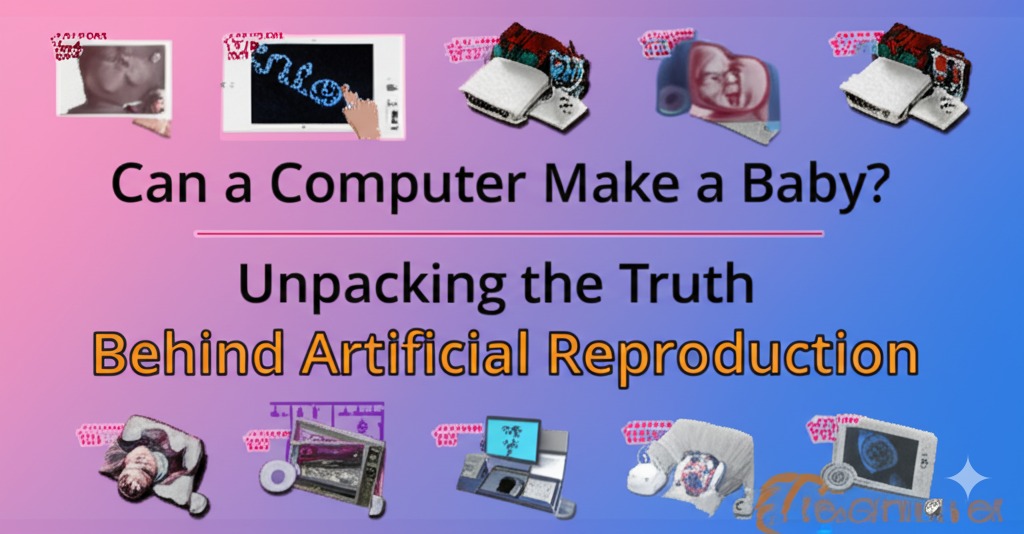In a world where technology continues to evolve at a rapid pace, it’s not uncommon to wonder just how far its capabilities stretch. From artificial intelligence that mimics human behavior to robots capable of performing complex tasks, the line between science fiction and reality is getting blurrier by the day. But what about one of the most fundamental aspects of human existence—reproduction? Can a computer really make a baby? Let’s dive into this intriguing question and explore the potential intersections of technology, biology, and reproduction.
The Role of Computers in Reproduction: An Overview
Before answering the question of whether a computer can make a baby, it’s essential to understand the role that technology currently plays in human reproduction. Advances in reproductive technology, such as in vitro fertilization (IVF), genetic engineering, and artificial insemination, have revolutionized the way we think about conceiving a child. However, these processes still require human involvement at various stages.
While computers and AI are making strides in many fields, biological processes like fertilization, pregnancy, and childbirth remain firmly in the hands of nature—or rather, in the hands of humans working with nature. So, can a computer take over the entire reproductive process? Let’s break it down further.
Can Computers Be Involved in Reproduction?
1. AI and Assisted Reproductive Technologies (ART)
Today, computers and AI are increasingly used in assisted reproductive technologies (ART). These technologies, which include IVF, egg freezing, and sperm donation, rely heavily on computers for tasks like monitoring, analysis, and decision-making. For example, AI is used to help identify the best embryos for implantation, predict outcomes of IVF cycles, and even screen for genetic disorders.
Key Takeaways:
- Computers can help improve the chances of a successful pregnancy by analyzing large amounts of data.
- AI can assist doctors in making more informed decisions about fertility treatments.
- However, AI still requires human expertise and cannot independently create a baby.
2. The Role of Genetic Engineering and CRISPR
Another area where computers are making a significant impact is in genetic engineering. Tools like CRISPR-Cas9 allow scientists to edit genes with unprecedented precision. Computers play a crucial role in mapping and analyzing DNA sequences, as well as designing the necessary alterations.
However, genetic engineering doesn’t equate to creating a baby from scratch. It is used to modify existing embryos or genetic material to avoid hereditary diseases, enhance certain traits, or study genetic functions. While it’s possible for computers to aid in creating a “designer baby,” they still don’t replace the biological processes of reproduction.
Key Takeaways:
- Genetic engineering and AI technologies enable precise modifications to human DNA.
- The technology is still in its early stages and is heavily regulated.
- The role of computers is more focused on editing than creating a human life independently.
Can Computers Create Life? The Science Behind Biological Reproduction
At the core of this question lies a deeper issue: can machines replicate or replace biological processes? Reproduction in humans involves complex biological systems that computers simply cannot replicate at this stage. Fertilization, the development of embryos, and gestation all rely on intricate biological processes that computers cannot emulate.
1. Artificial Wombs and the Future of Reproduction
One area where technology is trying to simulate biological processes is in the development of artificial wombs. Scientists are working on creating environments where embryos can develop outside the human body, often referred to as “ectogenesis.” While this technology has made significant progress in animals, it’s still far from being able to create a human baby entirely within an artificial environment.
In the future, artificial wombs could help premature babies survive or offer a new way for people who are unable to carry a pregnancy to have children. But, even with this advancement, the process would still require human involvement at various stages.
Key Takeaways:
- Artificial wombs could allow for the external development of embryos, but they don’t completely replace human reproduction.
- The technology is still in its infancy and is unlikely to create babies without human genetic material.
2. The Limitations of AI and Computers in Biology
AI and computers are powerful tools in medicine and science, but they cannot fully replicate the intricate and multifaceted process of human reproduction. While they can assist in diagnostics, decision-making, and genetic research, the biological process of conceiving and growing a child involves countless variables that technology cannot replicate. AI lacks the ability to reproduce life autonomously or give birth to a baby.
The Ethical and Social Implications of AI in Reproduction
The concept of using computers and AI in human reproduction raises profound ethical questions. If AI becomes capable of playing a larger role in reproduction, such as in designing embryos or even creating life in artificial environments, who controls that process? What are the long-term effects of genetically engineered children, and how might society handle the implications of “designer babies”?
As technology advances, it’s essential to maintain a dialogue about the ethical boundaries of AI in reproduction. These discussions will help shape policies that ensure the technology is used responsibly and benefits society without undermining human dignity or equality.
Conclusion: Can a Computer Make a Baby?
While computers and AI have made great strides in assisting with reproductive technologies, there is still a long way to go before they can independently create a baby. Today, technology can enhance the chances of conception and help with various stages of reproduction, but the biological process itself remains firmly in the realm of nature.
As we look toward the future, advances in artificial wombs, genetic engineering, and AI could potentially transform the way we think about reproduction. However, these developments should be approached with caution and ethical considerations. Computers, at least for now, can’t make babies on their own—but they are certainly reshaping the way we understand and approach reproduction.

Caleb Carlson is a contributing writer at Computer Site Engineering, specializing in computer technology, software trends, and hardware innovations. His articles simplify complex tech topics, making them accessible to readers of all levels.





